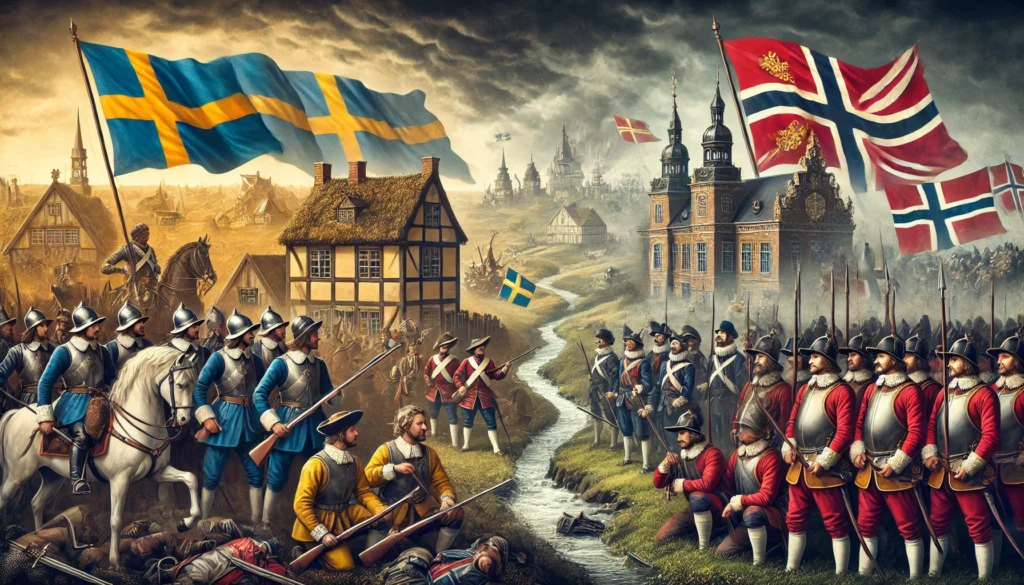Rivalry Between Sweden and Denmark-Norway in the 17th Century
Geopolitical Rivalry In the 17th century, Sweden and Denmark-Norway were the two dominant powers in the Nordic region. Their rivalry was characterized by a struggle for control over territories, trade routes, and political influence. This competition had deep historical roots and was further intensified by the personal ambitions of their respective kings, Gustav II Adolf and Christian IV.

Territorial Disputes The main conflict between Sweden and Denmark-Norway revolved around control of strategic territories and important trade routes, particularly in the Baltic Sea area. Both nations aimed to dominate Baltic trade, leading to repeated clashes:
- Kalmar War (1611-1613): Denmark-Norway sought to curb Sweden’s eastern expansion, particularly after Sweden had grown in strength and influence. The war was triggered by territorial disputes and Denmark’s efforts to maintain control over the Sound Toll, a crucial source of income.
- Torstenson War (1643-1645): Even after Gustav II Adolf’s death, the rivalry continued. This war largely focused on control over areas such as Jämtland, Härjedalen, Gotland, and Ösel, which Sweden eventually won.
Economic Factors Economic considerations played a significant role in the conflict. Both countries wanted to dominate Baltic trade, which was vital for their economies:
- Sweden: Under Gustav II Adolf, Sweden underwent significant economic reforms that modernized the country. Sweden focused on exporting iron and copper, which were highly sought after in Europe. Economic growth was also driven by territorial conquests that provided access to new resources.
- Denmark-Norway: Christian IV was known for his ambitious construction projects and attempts at economic reform. He aimed to strengthen control over toll revenues from the Sound, a strategically important waterway for trade between the Baltic Sea and the North Sea. Although Denmark-Norway had a stronger economic base, the wars and major construction projects led to increased national debt and economic challenges.
Comparison of Economies and Welfare
- Sweden: Economic reforms under Gustav II Adolf led to increased efficiency in managing state resources. Sweden experienced economic growth, but the wars required significant expenditures and strained the economy. Wages were generally low, and the population struggled to meet basic needs, especially during wartime.
- Denmark-Norway: Christian IV’s reign was marked by major construction projects and efforts to strengthen the economy through trade and industry. However, the extensive wars led to economic exhaustion. The tax burden increased, and many citizens faced economic hardships.
Disease and Food Supply Both countries were affected by plague epidemics, which reduced the population and further weakened the economy:
- Sweden: Plague epidemics in the 1620s and 1630s caused significant population losses and exacerbated the economic problems resulting from ongoing wars. Food supply was also affected, leading to famine in some areas.
- Denmark-Norway: Similarly, plague epidemics hit hard, and the population struggled with disease and food shortages. The economic challenges were compounded by the large expenditures on warfare and construction projects.
Ambitions for Greatness Both Gustav II Adolf and Christian IV had ambitions for greatness that drove their policies and military engagements:
- Gustav II Adolf: He aimed to make Sweden a leading military power in Europe and sought to expand Sweden’s territorial control. His skill as a military leader and innovations in military strategy made him a key figure in the Thirty Years’ War.
- Christian IV: He sought to strengthen Denmark-Norway’s position as a leading trading and maritime nation in the Nordic region. His construction projects and economic reforms reflected his ambitions to leave a strong and prosperous kingdom.
Conclusion The conflict between Gustav II Adolf and Christian IV was driven by both territorial and economic factors, as well as their personal ambitions to enhance their respective nations’ power and influence in the Nordic region. Their rivalry resulted in a series of wars that shaped the balance of power in the region and had lasting consequences for both countries’ economies and populations.
Hashtags
#History, #NordicRivalry, #Sweden, #Denmark, #Norway, #17thCentury, #BalticSea, #MilitaryHistory, #Economy, #TerritorialConflict, #Conflict, #Disease, #GustavIIAdolf, #ChristianIV,

Du må være logget inn for å legge inn en kommentar.